The Arctic Convoy Club
of New Zealand

Veterans of the Arctic Convoys 1941 -


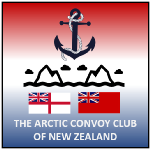

Members’ Ships : Royal Navy : P to T
Ships listed on this page:
HMS Palomares; HMS Queen; HMS Renown; HMS Rodney; HMS Sheffield; HMS Speedwell; HMS Speedy; HMS Striker; HMS Suffolk; HMS Tartar; HMS Tracker; HMS Trinidad
ACCNZ Member that served on this ship:
Christopher Turnbull, Christchurch (deceased)
HMS Palomares was originally MV Palomares, built by William Doxford & Sons, Sunderland yard in 1937 and sailed as a merchant fruit carrier ship (13.5 knot banana boat) for service on the MacAndrews Line in January 1938 with their Spanish service.
She was purchased by the British Admiralty in 1940, as these fruit ships were considered to be fast and manoeuvrable. In 1941 the Admiralty converted her and seven others to Anti-
In March 1942, she sailed with Pozarica, and the corvettes Poppy, Lotus, La Malouine and Dianella for the port of Seyðisfjörður. In June 1942, she sailed as an escort in the infamous Convoy PQ-
In November 1942, HMS Palomares took part in the Operation Torch landings in Algiers as an Anti Aircraft ship. The ship left Gibraltar on the 3rd and arriving on the 8th. However the next day Palomares was hit by a bomb suffering a large number of casualties, engulfed in flames her steering gear was put out of action. Deceased seamen were transferred to the corvette Samphire for burial at sea and her steering gear was repaired by the 10th.
In September 1943, during the Salerno landings of Italy on the 9th, Palomares was a Fighter Direction ship, directing fighter planes with her radar system. In January 1944, Palomares again served as a Fighter Direction ship during the Anzio landings. Arriving at the beachhead on the 22nd, she struck a mine and was towed back to Naples by the tugs Edenshaw and Evea. In September 1945, Palomares was to have participated in the Malaya landings but couldn't as fire damaged her engine room.
Upon being converted as an Anti Aircraft ship HMS Palomares was equipped with: 8 4" AA guns and 8 2 pounder AA guns. In December 1942, to take the role as a fighter-
From April 1941-
Surviving the war, HMS Palomares was returned to the MacAndrews Line in 1946, where she continued service until the mid-
HMS Palomares sailed in convoys: PQ17 + QP14
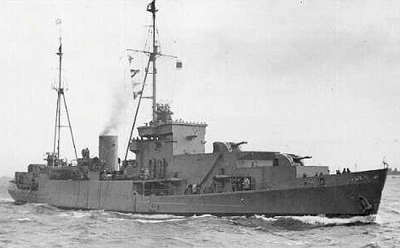

ACCNZ Member that served on this ship:
Allan Gore, Geraldine (deceased)
An "Ameer" class escort carrier of 10,200 tons. Built by Seattle-
Badge date: 1944
HMS Queen sailed in convoys: JW67 + RA67
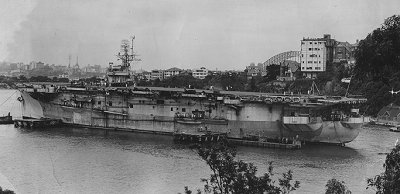
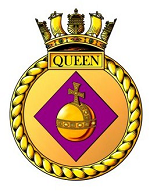

ACCNZ Member that served on this ship:
David McNab, Christchurch (deceased)
HMS Rodney (pennant number 29) was one of two Nelson-
As her superstructure was located aft of midships like RN fleet oilers whose names carried the ...'ol' suffix, she was sometimes derisively referred to as "Rodnol". Commissioned in 1927, Rodney served extensively in the Mediterranean Sea and Atlantic Ocean during World War II.
Rodney played a major role in the sinking of the German battleship Bismarck in May 1941.
During and after Operation Torch and the Normandy landings, Rodney participated in several coastal bombardments. In poor condition from extremely heavy use and lack of refits, she was scrapped in 1948.
Known as 'Queen Anne's Mansions' owing to the resemblance of the bridge structure to the well-
Rodney was laid down on 28 December 1922, the same date as her sister ship Nelson. Construction of the ship was carried out at Birkenhead by Cammell-
From commissioning until World War II broke out in September 1939, Rodney spent the entire time with the British Atlantic Fleet or Home Fleet. In 1931, her crew joined the crews of other ships taking part in the Invergordon Mutiny. In October 1938 a prototype type 79Y radar system was installed on Rodney's masthead. She was the first battleship in the Royal Navy to be so equipped. In 1940 the type 79Y radar was replaced with type 279 and UP AA rocket projectors were fitted to 'B' and 'C' turrets, but removed in 1941 after concern about their safety and effectiveness. These were replaced by 35 single 20 mm Oerlikons over the next three years.
Following the sinking of armed merchant cruiser HMS Rawalpindi on 23 November 1939 by the German battleships Scharnhorst and Gneisenau, Rodney hunted the enemy ships but developed serious rudder defects and was forced to return to Liverpool for steering gear repairs until 31 December. Rodney was damaged by German aircraft at Karmoy, near Stavanger on 9 April 1940, when hit by a 500 kg (1,102 lb) bomb that pierced the upper deck aft of the funnel, but did not explode and exited sideways after striking the armoured deck. On 13 September, she was transferred from Scapa Flow to Rosyth with orders to operate in the English Channel when the German invasion of Britain was expected. In November and December, Rodney was assigned convoy escort duties between Britain and Halifax, Nova Scotia. In January 1941, Rodney joined the hunt for the German battleships Scharnhorst and Gneisenau, without success. On 16 March, however, while escorting a convoy in the North Atlantic, contact was made with the German battleships, but no battle followed, as the German ships turned away when they realised that they were facing superior firepower.
In May 1941, while commanded by Captain Frederick Dalrymple-
It was during this run on 24 May that she was called on by the Admiralty to join in the pursuit of the German battleship Bismarck, leaving the destroyer Eskimo to escort Britannic and taking Somali, Mashona and Tartar with her in the search. Despite Admiral Sir John Tovey in the battleship King George V heading north-
Early on the morning of 27 May 1941, along with the battleship King George V and the cruisers Norfolk and Dorsetshire, she engaged Bismarck, which had damaged rudder machinery due to a torpedo launched by the aircraft carrier Ark Royal's Swordfish bombers the day before. Unable to manoeuvre and listing to port, Bismarck scored no hits before her forward guns were knocked out, after which Rodney closed with Bismarck until she was firing on a virtually flat trajectory, and spotters could actually follow the shells to the target. One 16-
After refuelling at Gourock, Rodney sailed to the South Boston Navy Yard in Boston, Massachusetts, for the previously scheduled repairs to her engines and the installation of more 8-
In September 1941, Rodney was stationed with Force H in Gibraltar, escorting convoys to Malta. In November, she returned home and was stationed in Iceland for a month and then underwent refit and repair until May 1942. After the refit, she returned to Force H, where she again escorted Malta convoys and took part in Operation Torch, the invasion of Northwest Africa. She was subsequently involved with the Invasion of Sicily and Salerno. From October 1943, she was in the Home Fleet, and took part in the Normandy invasion in June 1944, where she was controlled from the headquarters ship HMS Largs off Sword Beach. Her tasks included a 30-
Rodney began the war in need of an overhaul. In November 1939 defects in her rudder required repairs in Liverpool. In early 1940 as a result of panting leaking developed between watertight bulkheads 9 and 16. The crew effected temporary repairs by welding on a support beam. However, Rodney continued to suffer leaking due to defective riveting. No permanent repairs were carried out even after the leaking increased following two near misses from German bombs in April 1940.
During a gale in December 1940 Rodney experienced heavy panting and the beam added by the crew broke off. The two watertight compartments in the affected area flooded. The situation worsened as a result of a hole previously drilled into the watertight bulkhead by an officer to provide access for a hose connected to a portable pump. As a result of this hole the flooding expanded into the platform deck. The gale also tore the covers off the navel pipes which resulted in the cable-
During the entire war Rodney steamed over 156,000 nautical miles (289,000 km) with no engine overhaul after 1942. Because of the frequent machinery problems, hull defects, and the fact that Rodney had not been upgraded to the extent of her sister Nelson, starting in December 1944 she became the flagship of the Home Fleet based at Scapa Flow and rarely left her mooring. HMS Rodney was scrapped at Thos W Ward Inverkeithing, starting on 26 March 1948.
HMS Rodney sailed in convoys: JW60 + RA60. Motto: "Non generant aquilae columbas" "Eagles don’t breed doves". Badge date: 1923
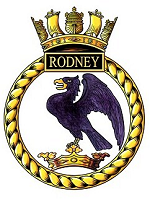
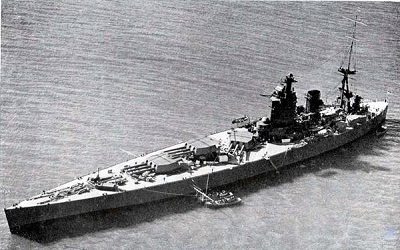

ACCNZ Member that served on this ship:
Bill Gallie, Napier
Type: Battlecruiser. Class: Renown. Built by: Fairfield Shipbuilding & Engineering Co. (Govan, Scotland). Ordered: 29 December 1914. Laid down: 25 January 1915. Launched: 4 March 1916. Commissioned: 20 September 1916. HMS Renown served with the Grand Fleet in the North Sea during the remaining two years of World War I. In 1920-
After a decade of further service, Renown was again reconstructed, greatly changing her appearance and giving her a modern anti-
This work was completed in September 1939, just after the outbreak of the Second World War. Renown's high speed made her a valuable asset during World War II. In late 1939, she was sent to the South Atlantic to search for the German armoured ship Admiral Graf Spee. She covered mine laying operations along the Norwegian coast in early April 1940 and, on the 9th of that month, engaged the German battleships Scharnhorst and Gneisenau, damaging the latter.
HMS Renown sailed in convoys: PQ12 + PQ13 + QP9. Motto: "Antiquae Famae Custos" "Guardian of ancient renown". Badge date: 1919
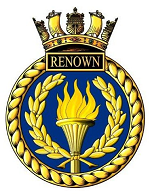
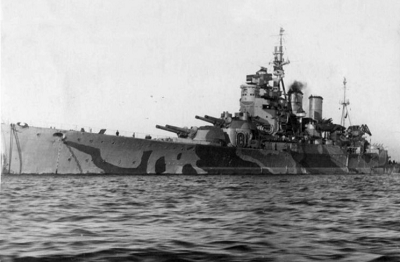

Later in 1940 and into 1941, she operated with Force H, based at Gibraltar to provide strategic presence in both the Atlantic and Mediterranean. While with Force H, she participated in a bombardment of Genoa, Italy, in February 1941.
After Home Fleet service in 1942-
ACCNZ Member that served on this ship:
Arthur Basset-
HMS Sheffield (C24) was one of the Southampton sub class of the Town class cruisers of the Royal Navy during the Second World War. She took part in actions against several major German warships. At the outbreak of war, Sheffield served with the 18th Cruiser Squadron, patrolling the Denmark Straits and then, in April 1940, she was engaged in the Norway campaign. After a short spell carrying out anti-
In 1941, she participated in the shelling of Genoa (9 February), operations against Vichy convoys and supporting air reinforcements to Malta. In May, Sheffield took part in the sinking of the German battleship Bismarck, narrowly escaping a friendly fire torpedo attack by HMS Ark Royal's Fairey Swordfish aircraft. On 12 June, she located and sank one of Bismarck's tankers, the Friedrich Breme. After the destruction of another German supply ship, the Kota Penang in early October (with HMS Kenya), Sheffield returned to Britain. She was occupied on Arctic convoys until hitting a mine off Iceland on 3 March 1942 and was under repair until July. After more Arctic convoys, Sheffield joined the forces supporting the Allied landings in North Africa (Operation Torch) in November. In December, Sheffield and Jamaica formed "Force R", under the command of Rear-
In February 1943, Sheffield moved to operate in the Bay of Biscay and, in July and August, she supported the landings at Salerno (Operation Avalanche). Returning yet again to the Arctic, she took part in the sinking of the battleship Scharnhorst off the north coast of Norway, in late December. In 1944, Sheffield was an escort for the Royal Navy carrier force that executed a series of air attacks on the German battleship Tirpitz, between April and August. These had limited success and reponsibility was passed to the Royal Air Force. A lengthy refit in Boston and in Britain kept Sheffield out of action until after the end of the war.
The refit was completed in May 1946 and Sheffield alternated between duties in the West Indies (where in 1954 she served as flagship of the 8th Cruiser Squadron) and in home waters and the Mediterranean. There were further refits in 1949/50 and 1954. She went into reserve in January 1959 and became flagship of the Home Fleet until September 1964, when she was placed on the disposal list. Her equipment was removed at Rosyth in 1967 and the was then broken up at Faslane in the same year. The stainless steel ship's bell, which was made by Hadfield's of Sheffield, was preserved and today hangs in Sheffield Cathedral along with her battle ensign.
HMS Sheffield sailed in convoys: PQ5 + PQ18 + QP14 + JW51a + JW51b + JW52 + JW55a + JW55b + RA51 + RA52 + RA55a. Motto: "Deo adjuvante proficio" "With God’s help I advance". Badge date: 1935
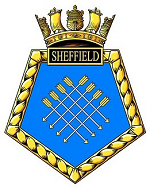
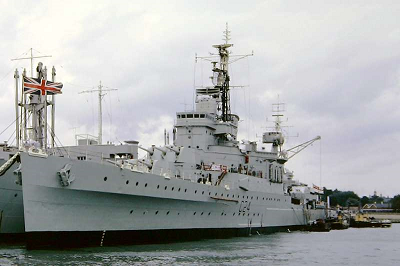

ACCNZ Member that served on this ship:
Les Edwards, Te Puke (deceased)
HMS Speedwell was completed on 30 September 1935 and joined the 1st Minesweeping Flotilla, attached to the Mediterranean Fleet, and was based at Alexandria. She returned to Devonport for a refit which was completed at the end of June 1936. She stayed in home waters undergoing a further refit at Devonport in early 1937 until July of 1937, when she left for the Mediterranean. Returning to the UK at the end of 1937, Speedwell was undergoing repairs, refit and re-
In July of the same year, she was at Sheerness, and placed in reserve, where she remained until, with the outbreak of the Second World War, being re-
In February 1940, HMS Speedwell, together with HMS Sphinx and HMS Skipjack, was sweeping north of Kinnaird Head. Sphinx was attacked by an enemy aircraft and heavily damaged; Speedwell took her in tow, and after the tow parted made repeated efforts to go alongside before the Sphinx finally sank. Speedwell took an active part in Operation 'Dynamo' -
In 1942 Speedwell took part in 'Operation Anklet', the raid on the Lofoten Islands; then escorted Russian convoys. Speedwell's Commanding Officer, Lt Cmdr J J Youngs, OBE, RNR, one officer and a rating were mentioned in despatches for devotion to duty while salvaging Harmatris. On 11 April the convoy in which Speedwell was operating was attacked five times by enemy aircraft, two of which were shot down and several others damaged. During June, Speedwell picked up 37 survivors from the Russian SS KIEV, which had been torpedoed. Enemy aircraft again attacked the convoy and four were shot down. A U-
Later in 1942 Speedwell escorted a convoy to Gibraltar, then operated off the North African coast where she went to the assistance of the fast minelayer Manxman which had been torpedoed. In May 1943, she was involved in Operation Antidote, a minesweeping operation in the Mediterranean, off the coast of Tunisia, which had just been cleared of enemy forces. For the work performed by his ship in this operation, Speedwell's Commanding Officer, Lieutenant Commander T E Williams, RD, RNR, was awarded the DSC. Later in May 1943, Speedwell returned to the UK and was based at Leith during the summer.
In September 1943 she relieved HMS Britomart working in North Russian waters until February 1944. While escorting the US tanker Culpepper on 25 October 1943, Speedwell ran aground off Akureyri. No damage was caused and both ships later arrived at Hvalfjord. On return, Speedwell joined 1st MSF working off the east coast. During the assault phase of the invasion of Normandy on 6 June 1944, Speedwell was one of the vessels which swept a channel for Force 5, the naval force which covered the landing at Ouistreham. She afterwards assisted in keeping mines out of the swept channels for the passage of troops, munitions and supplies to the Allied Armies. For the remainder of the war, HMS Speedwell continued to carry out minesweeping duties between Harwich and the Continent, latterly clearing the route to Hamburg and in the Heligoland Bight. At the end of 1945 she was reduced to the reserve at Chatham and laid up at Harwich. On 5 December 1946 she was sold and became the merchant vessel Topaz, registered at Antwerp. Whilst en route to the Dutch ship breakers on 11 May 1954, she was wrecked and later scrapped at Dordrecht.
HMS Speedwell sailed in convoys: PQ8 + PQ12 + PQ13 + QP6 + QP7 + QP9 + QP10 + JW54B + JW55A + RA55B + RA56. Motto: "Celeriter festina" "Hasten swiftly" and "Bene festina" "Speed well". Badge date: 1934
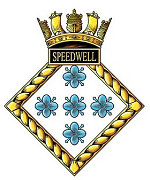
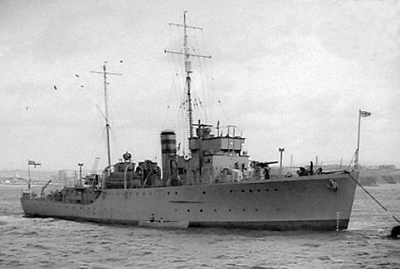

ACCNZ Member that served on this ship:
Tom Moss, Christchurch
A "Halcyon" class Fleet Minesweeper of 875 tons built by W . Hamilton & Co., Glen Yard, Port Glasgow, Scotland. Commissioned 7 April 1939 at Portsmouth for service with 1st MSF. During 1941/42 based at Polyarno (Russia) sweeping approaches to Murmansk and Archangel. In June 1942 joined convoy to Malta and joined 17th MSF sweeping approaches to Malta where she was based until 8 August 1943. Re-
HMS Speedy sailed on convoys: PQ2 + PQ3 + PQ4 + PQ14 + QP4. Motto: "Virtute et Labore" "By virtue and labour". Badge date: 1920
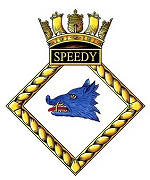
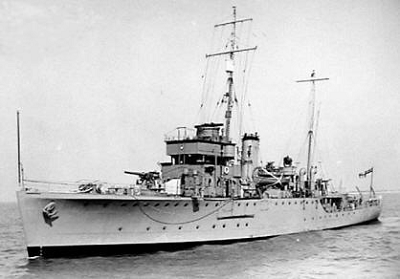

ACCNZ Member that served on this ship:
David Owen (deceased), Christchurch
An "Attacker" class escort carrier obtained under Lend-
Badge date: 1943
HMS Striker sailed in convoys: JW59 + RA59 + JW60 + RA60
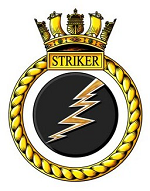
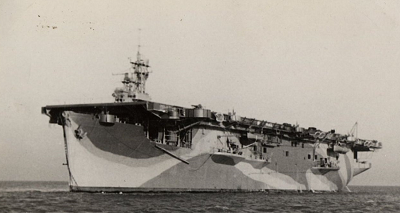

HMS Suffolk (55)
ACCNZ Member that served on this ship:
William Abbey (deceased)
HMS Suffolk (55) was a Kent class cruiser of the Royal Navy. She was built by Portsmouth Dockyard, Portsmouth, UK), with the keel being laid down on the 15 November 1924. She was launched on the 16 March 1926, and commissioned 25 June 1928. Suffolk, like her sisters, served on the China Station, save for reconstruction, until the outbreak of World War II. She came home in 1939 and then patrolled the Denmark Straits in October 1939. In April 1940 she participated in the Norwegian Campaign. On 13 April 1940 she arrived at Tórshavn to commence the British pre-
On 17 April 1940 Suffolk bombarded the air field and station for sea planes at Sola Air Station, Stavanger, destroying four aircraft and damaging the installations, but was in return badly damaged by bombs from German Ju88 aircraft of II./KG 30. X-
During May 1941 Suffolk was involved in the Battle of the Denmark Strait and the sinking of the German battleship Bismarck. Suffolk had engaged the battleship twice during the battle making several salvoes on her. Bismarck finally sank on 27 May 1941. After her repairs Suffolk served with the Home Fleet in Arctic waters until the end of 1942, then underwent a refit between December 1942 and April 1943. On completion of this the ship was ordered to the Eastern Fleet, operating in the Indian Ocean until the end of the war. Suffolk was allocated to Bisco on 25 March 1948 and was scrapped at J Cashmore's (Newport, Wales) where she arrived on 24 June 1948.
HMS Suffolk sailed in convoys: PQ1 + PQ18 + QP14 + QP15. Motto: "Nous Maintiendrons" "We shall maintain". Badge date: 1926
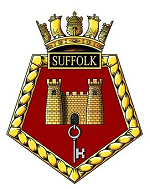
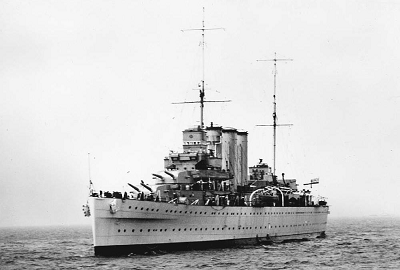

ACCNZ Member that served on this ship:
Wilf Goodier, Napier (deceased)
HMS Tartar (L43, later F43) was a Tribal-
HMS Tartar sailed in convoys: PQ7b + PQ12 + PQ13 + PQ18 + QP5 + QP9 + QP14. Ship's Motto: "Without Fear". Badge date: 1939
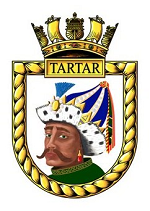


ACCNZ Member that served on this ship:
F N (Noel) Smith (deceased) Christchurch; William (Bill) Carson (deceased)
HMS Trinidad (C46) was a "Fiji" class light cruiser of 8,000 tons ordered from HM Dockyard Devonport on 1 December 1937 and laid down on 21 April 1938. It was launched 21 March 1940 as the 3rd Royal Navy ship to carry the name. After damage by a bomb hit on the quarterdeck during an air raid on Plymouth in April 1941 she was taken to HM Dockyard, Rosyth where work was completed on 14 October, the ship being fitted with newly developed fire-
While escorting PQ13 in March,1942 she and other escorts were in combat with German Narvik class destroyers.
She hit and sank "Z26" and then launched a torpedo attack. One of her torpedoes had a faulty gyro mechanism which resulted in it performing a circular arc striking herself, killing 32 men. She was towed clear of the action and proceeded under her own steam toward Murmansk. The German U-
Undergoing partial repairs in Murmansk she set out to return home on 13 May 1942. En route she was attacked by more than 20 Ju88 bombers on 15 May 1942. All attacks missed except for one bomb which struck near the previous damage starting a serious fire. Lost were 63 men including twenty survivors from HMS Edinburgh which had been sunk two weeks earlier. The decision was taken to scuttle her and she was torpedoed by HMS Matchless and sank in the Arctic Ocean, north of North Cape.
HMS Trinidad sailed in convoys: PQ8 + PQ13 + QP6. Motto: "Have faith". Badge date: 1920
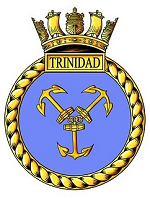
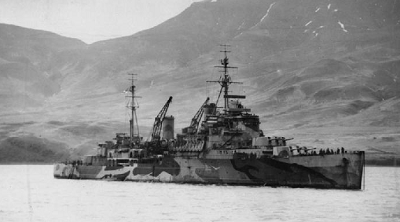

ACCNZ Member that served on this ship:
Derek McDonald, Levin (deceased)
HMS Tracker (D24) was a Bogue-
Tracker served as a convoy escort during 1943-
She originally carried Swordfish and Seafire aircraft of 813 Squadron; in January 1944 switching to the Avengers and Wildcats of 846 Squadron. In April 1944 her aircraft, together with those from HMS Activity were responsible for the sinking of U-
In August 1945 she made a final trip to the UK, being returned to the U.S. Navy in November 1945. She was sold in November 1946 and entered service as the merchant ship Corrientes, based in Argentina. She was scrapped in 1964.
HMS Tracker sailed in convoys: JW58 + JW61 + RA58 + RA61. Motto: "Re Rawira" "I am on the warpath". Badge date: 1943
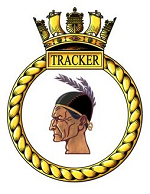
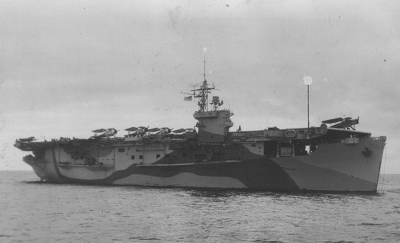

Links to other members’ ships:
HMS Activity; HMS Anson; HMS Apollo; SS Atlantic; HMS Bahamas; HMS Belfast; HMS Bermuda; HMS Berwick; HMS Black Prince; HMS Bluebell; HMS Byron; HMS Caesar; SS Cape Race; HMS Caprice; HMS Chiltern; HMS Dasher; HMS Diadem; SS Dolabella; HMS Drury; HMS Duke of York; HMS Echo; SS El Almirante; SS Eldena; SS Elona; SS Empire Beaumont; SS Empire Galliard; SS Empire Garrick; HMS Forester; HMS Furious; HMS Glasgow; HMS Goodall; SS Harmatris; HMS Howe; HMS Implacable; SS Induna; HMS Jamaica; HMS Javelin; HMS Kent; HMS Kenya; HMS Keppel; HMS King George V; RFA Laurelwood; HMS Loch Insh; HMS Loch Killin; HMS London; HMS Lookout; HMS Magpie; HMS Malcolm; HMS Musketeer; HMS Nabob; HMS Nelson; HMS Nigeria; HMS Norfolk; HMS Obedient; SS Ocean Freedom; HMS Offa; HMS Onslaught; HMS Onslow; HMS Victorious; HMS Vindex; HMS Volage; HMS Wakeful; and HMS Zealous
This website is owned by The Arctic Convoy Club of New Zealand © 2004 -
This page updated January 2024

This site uses images in SVG file format.
For best viewing results, please ensure you are using the latest version of your web browser.
| About Us |
| About Arctic Convoys |
| Convoy Kiwis |
| Greetings Exchange |
| Affiliations |
| Links |
| Topical Items |
| Decorations |
| Membership |
| My Story |
| Newsletter |
| Online Application Convoy Membership |
| Convoy Numbers |
| Merchant Navy Ships |
| Royal Fleet Auxiliary |
| Royal Navy Ships A - B |
| Royal Navy Ships C - F |
| Royal Navy Ships G - L |
| Royal Navy Ships M - O |
| Royal Navy Ships P - T |
| Royal Navy Ships U - Z |
| Obituaries |
| Wellington Memorials |
